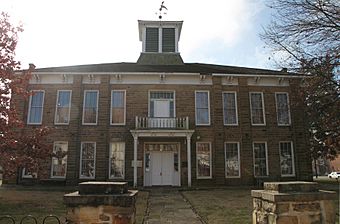Creek National Capitol facts for kids
|
Creek National Capitol
|
|
 |
|
| Location | 6th St. and Grand Ave., Okmulgee, Oklahoma |
|---|---|
| Built | 1878 |
| NRHP reference No. | 66000632 |
Quick facts for kids Significant dates |
|
| Added to NRHP | October 15, 1966 |
| Designated NHL | July 4, 1961 |
Creek National Capitol, also known as Creek Council House, is a building in downtown Okmulgee, Oklahoma, in the United States. It was capitol of the Muscogee (Creek) Nation from 1878 until 1907, when Oklahoma became a state. In 1919 the U.S. Department of the Interior sold the building to the city of Okmulgee. It was declared a National Historic Landmark in 1961. In November 2010 the city sold the building back to the tribe for $3.2 million. The building currently houses the Creek Council House Museum, with artifacts and exhibits about the history of the Muscogee tribe and the arts and crafts of other Native American tribes.
History
In 1837 the majority of the Muscogee tribe members were forced to move west by the U.S. government during the Trail of Tears. Survivors of the trek arrived in what was called the Indian Territory and held a meeting at the historic Council Oak Tree in the city of Tulsa, Oklahoma. During the American Civil War, tribal unity was tested when many tribe members participated on both sides of the conflict, despite attempts by leaders of the tribe to keep it neutral. In 1867 the Muscogee (Creek) Nation was established in the Indian Territory, with its governmental headquarters in the city of Okmulgee. The next year a double-log two-story council house was constructed to conduct tribal business. On October 17, 1877 an act was passed by the council and approved by Chief Ward Coachman appropriating $10,000 for the construction of a new capitol building of stone or brick upon the site of the log council house. On January 10, 1878 the old Council House was sold for $60, with the tribe reconvening at the new Council House on September 23. The new Council House contained separate chambers for the executive and judicial branches of the government, with the legislative branch divided into the House of Kings and House of Warriors.
In 1906 the U.S. government passed of the Five Civilized Tribes Act, ending national self-governance for the Muscogee Creek Nation and the other four tribes. In 1907 the Indian Territory was integrated into the state of Oklahoma. The same year, the Muscogee Nation's Council House was leased to Okmulgee County for $2,000 a year to serve as the Okmulgee County Courthouse, which continued until 1917. In 1908 the U.S. Congress authorized the Secretary of the Interior to "take possession of all lands belonging to the Five Civilized Tribes, now or heretofore used for government, school, or other tribal purposes...". In 1919 the City of Okmulgee purchased the Creek Council House and its grounds for $100,000 under the supervision of the Department of the Interior, with the proceeds of the sale being deposited in the U.S. Treasury in the name of the tribe. In the 1920s citizens of the City of Okmulgee called for the Council House to either be torn down or turned into a hotel. Attempts to do this ended when Will Rogers visited the city and called for the Council House's preservation. On April 24, 1923 the Creek Indian Memorial Association was formed to protect the historical monuments of the Muscogee tribe. In 1934 the Oklahoma Indian Welfare Act was passed to help the tribes regain their sovereign status. Between the 1930s and 1960s, with the Creek Council House in the possession of the City of Okmulgee, it was used as a sheriff's office, a Boy Scout meeting room, and a YMCA.
In 1961 the Council House and the grounds around it were listed on the National Register of Historic Sites and was designated as a National Historic Landmark. In 1970 Congress allowed the Five Tribes to democratically elect their chiefs, with the Muscogee (Creek) Nation electing Claude Cox as its chief the next year. In 1979 the Muscogee (Creek) Nation adopted a new consistution to replace the one from 1867 and began designating land for the construction of tribal governmental buildings. The tribal government was restructured to have executive, legislative, and judicial branches, and departments for education and health were created. In 1989 the CIMA raised $1 million to restore the Creek Council House and gained the 501-C-3 tax exempt status. In 1992 the restoration of the Council House was completed, with the building being opened as a museum of the Muscogee tribe's history. In 1993 the Creek Council House Museum received the National Preservation Honor Award from the National Trust for Historic Preservation for its restoration work on the Council House building. In 1997 the City of Okmulgee agreed to pay the CIMA $149,650 annually for the museum's operation. In 2005 the CIMA was renamed to the Creek Council House Museum Association. In August 2010, after several months of negotiations, the City of Okmulgee agreed to sell the Council House back to the Muscogee (Creek) Nation for $3.2 million. Two months later, a ceremony was held to commemorate the repossession of the building by the Muscogee (Creek) Nation.



